|
|
|
 |
|
| Hanwei Combat Helmet (Hinged Faceplate) (AH2108) |
Points: 15


|
Our two Combat Helms are both crafted in 14 gauge steel, to comply with the combat regulations of many re-enactment societies, with solidly welded bar attachments. The finish is satin black and the interior is unlined for customization to individual preferences. The AH2108 has a hinged faceplate (hinges up when not in use), while the AH2109 model is of one-piece construction. Bar spacing on both complies with most societal regulations.
|
|
|
|
|
|
 |
|
| Hanwei Katana-Bokken Case |
Points: 4
|
Due to demand, we offer high quality Sword Cases (OH2158 & OH2159) for your traveling needs. These sword cases are available in a medium(OH2159) and large(OH2158) size. They are constructed from black high-density fabric and the bottom of the bag is reinforced with thick leather. A shoulder strap and carrying handle are equipped on the cases for traveling convenience. Each case has two inside zipped-compartments for storage security and an outer compartment for maintenance supplies. These cases can hold a plethora of swords depending on various shapes and sizes. These sword cases are perfect for those who travel frequently with their swords across country or across town.
OH2158 will carry any combination of three katana and bokken
OH2159 will carry two katana or katana and bokken
|
|
|
|
|
|
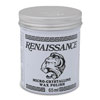 |
|
| Renaissance Wax |
Points: 10

|
For over forty years, Renaissance Wax has been the No. 1 choice of museums for the preservation of precious items including swords and other edged weapons. Professional conservators throughout the world depend on Renaissance Wax to protect their collections. Properly applied, a little goes a long way.
|
|
|
|
|
|
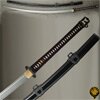 |
|
| Hanwei Odachi (SH2392) |
Points: 40

|
Forging and heat treating a 49" blade is a tough task but the Hanwei smiths have mastered the technique and we're excited to bring you our functional and historically accurate Odachi. The "O" means great and we're not kidding. With an overall length of 67" there's only one way to describe this sword - large! Patterned after an original from the 14th Century, when Odachi were still in use on the field of battle, this sword is a must for Japanese sword enthusiasts.
Sold Out
|
|
|
|
|
|
 |
|
| Zatoichi Stick/Sword (Forged) (SH2267) |
Points: 13

|
CAS Hanwei now has four exciting versions of the stick sword of Zatoichi, the legendary blind Samurai. The ever-popular black SH1014, with its fully tempered carbon steel blade is now joined by the SH2298, featuring the same blade but with the red lacquered scabbard seen in many of Zatoichi's screen adventures The SH2267 features a fully-forged straight Katana blade, housed in a natural hardwood scabbard and handle combination, while the superbly folded blade of the SH2114 makes a welcome return housed in exquisite rosewood.
Sold Out
|
|
|
|
|
|
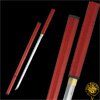 |
|
| Hanwei Zatoichi Stick/Sword (Red Scabbard) (SH2298) |
Points: 18

|
CAS Hanwei now has four exciting versions of the stick sword of Zatoichi, the legendary blind Samurai. The ever-popular black SH1014, with its fully tempered carbon steel blade is now joined by the SH2298, featuring the same blade but with the red lacquered scabbard seen in many of Zatoichi's screen adventures The SH2267 features a fully-forged straight Katana blade, housed in a natural hardwood scabbard and handle combination, while the superbly folded blade of the SH2114 makes a welcome return housed in exquisite rosewood.
Sold Out
|
|
|
|
|
|
 |
|
| Hanwei Zatoichi Stick/Sword (Folded) (SH2114) |
Points: 35

|
CAS Hanwei now has four exciting versions of the stick sword of Zatoichi, the legendary blind Samurai. The ever-popular black SH1014, with its fully tempered carbon steel blade is now joined by the SH2298, featuring the same blade but with the red lacquered scabbard seen in many of Zatoichi's screen adventures The SH2267 features a fully-forged straight Katana blade, housed in a natural hardwood scabbard and handle combination, while the superbly folded blade of the SH2114 makes a welcome return housed in rosewood.
Sold Out
|
|
|
|
|
|
 |
|
| Hanwei Bamboo Mat Wakizashi (SH2448) |
Points: 20

|
Our Bamboo Mat Wakizashi features a chu-kissaki blade of Hanwei's own high-alloy HWS-2S steel, which combines impressive performance with a striking O-choji hamon. This steel is made in Hanwei's new factory, with high-tech equipment, producing a very pure, advanced-metallurgy blade with excellent edge-holding capability and resilience.
The fittings feature a bamboo-themed black iron tsuba, textured in a bamboo mat design with a jointed bamboo rim and highlighted with gold-tipped bamboo leaves. The fuchi/kashira follow the same theme and the golden menuki feature a pair of sparrows. The saya is finished in high-gloss lacquer with horn fittings.
Sold Out
|
|
|
|
|
|
 |
|
| Hanwei Lion Dog Wakizashi (SH2449) |
Points: 25

|
The Lion Dog Wakizashi features an O-Kissaki blade of Hanwei's own high-alloy HWS-1S steel, which combines superior performance with an outstanding O-choji hamon. This steel is made in Hanwei's new factory, with high-tech equipment, producing a very pure advanced-metallurgy blade with the best edge-holding capability and resilience of any blade ever produced by Hanwei. The outstanding performance characteristics of blades forged from HWS-1S steel derive from a combination of the careful selection of alloying elements and a complex processing procedure, basically involving the manipulation of the steel’s carbon content across the blade section. This results in a very tough and resilient blade with a hard, highly abrasion-resistant edge
Sold Out
|
|
|
|
|
|
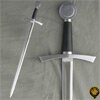 |
|
| Hanwei Lionheart Sword (SH2367) |
Points: 11

|
The single-hand Lionheart Sword is typical of the cruciform-hilt style of the crusading knights of Europe in the 12th and 13th centuries. The wheel pommel and slightly turned-down bow-tie guard make this a very attractive sword indeed! Iberia Swords are crafted in much the same way as swords were made centuries ago, except that the blades are now forged from high-carbon spring steel, a resource unavailable off-the-shelf to the smiths of the old. The blade finish is far from being polished, again more closely replicating what the medieval swordsmith was able to achieve. Except as noted, grips are leather-covered hardwood. Fittings are either steel or solid brass. Except, where shown all of these swords have scabbards of leather-covered fiberglass with steel lockets and chapes and removable suspension rings. These swords will appeal to the re-enactor who wants a sword with the same appearance as the originals.
Sold Out
|
|
|
|
|
|
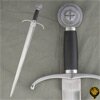 |
|
| Hanwei Henry V Sword (SH2369) |
Points: 11

|
The Henry V Sword is modeled after the sword hung over the tomb of one of England's great warrior kings. The single-handed cut-and-thrust weapon combines a relatively short sturdy blade with elegant down-swept quillons and a wheel pommel. Iberia Swords are crafted in much the same way as swords were made centuries ago, except that the blades are now forged from high-carbon spring steel, a resource unavailable off-the-shelf to the smiths of the old. The blade finish is far from being polished, again more closely replicating what the medieval swordsmith was able to achieve. Except as noted, grips are leather-covered hardwood. Fittings are either steel or solid brass. Except, where shown all of these swords have scabbards of leather-covered fiberglass with steel lockets and chapes and removable suspension rings. These swords will appeal to the re-enactor who wants a sword with the same appearance as the originals.
Sold Out
|
|
|
|
|
|
 |
|
| Hanwei Agincourt Sword (SH2371) |
Points: 11

|
The Agincourt, an English-style single-hand sword, commemorates one of the memorable battles of the Hundred Year's War between England and France. Iberia Swords are crafted in much the same way as swords were made centuries ago, except that the blades are now forged from high-carbon spring steel, a resource unavailable off-the-shelf to the smiths of the old. The blade finish is far from being polished, again more closely replicating what the medieval swordsmith was able to achieve. Except as noted, grips are leather-covered hardwood. Fittings are either steel or solid brass. Except, where shown all of these swords have scabbards of leather-covered fiberglass with steel lockets and chapes and removable suspension rings. These swords will appeal to the re-enactor who wants a sword with the same appearance as the originals.
Sold Out
|
|
|
|
|
|
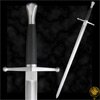 |
|
| Hanwei War Sword (SH2366) |
Points: 11

|
The War Sword is a hand-and-a-half design from the early 14th century. The hardwood grip and elongated scent-stopper pommel make the 32" blade surprisingly easy to handle. Iberia Swords are crafted in much the same way as swords were made centuries ago, except that the blades are now forged from high-carbon spring steel, a resource unavailable off-the-shelf to the smiths of the old. The blade finish is far from being polished, again more closely replicating what the medieval swordsmith was able to achieve. Except as noted, grips are leather-covered hardwood. Fittings are either steel or solid brass. Except, where shown all of these swords have scabbards of leather-covered fiberglass with steel lockets and chapes and removable suspension rings. These swords will appeal to the re-enactor who wants a sword with the same appearance as the original.
Sold Out
|
|
|
|
|
|
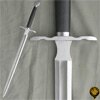 |
|
| Hanwei Hand and a Half Sword (SH2365) |
Points: 11

|
Hand-and-a-Half Sword, this version of a 16th century piece are a longtime favorite. Balance is excellent, providing a sword which lends itself to both single and two-handed use. Iberia Swords are crafted in much the same way as swords were made centuries ago, except that the blades are now forged from high-carbon spring steel, a resource unavailable off-the-shelf to the smiths of the old. The blade finish is far from being polished, again more closely replicating what the medieval swordsmith was able to achieve. Except as noted, grips are leather-covered hardwood. Fittings are either steel or solid brass. Except, where shown all of these swords have scabbards of leather-covered fiberglass with steel lockets and chapes and removable suspension rings. These swords will appeal to the re-enactor who wants a sword with the same appearance as the originals.
Sold Out
|
|
|
|
|
|
 |
|
| Hanwei Mercenary Sword (SH2368) |
Points: 13

|
The Mercenary is an imposing sword in the 15th century style. It featuring a triple-fullered blade, steel S-curve guard and scent stopper pommel. Supplied with a leather-covered belt scabbard. Iberia Swords are crafted in much the same way as swords were made centuries ago, except that the blades are now forged from high-carbon spring steel, a resource unavailable off-the-shelf to the smiths of the old. The blade finish is far from being polished, again more closely replicating what the medieval swordsmith was able to achieve. Except as noted, grips are leather-covered hardwood. Fittings are either steel or solid brass. Except, where shown all of these swords have scabbards of leather-covered fiberglass with steel lockets and chapes and removable suspension rings. These swords will appeal to the re-enactor who wants a sword with the same appearance as the originals.
Sold Out
|
|
|
|
|
|
|
|
Tags:
martial arts, katana, iaito, sword, fencing, tonfa, boken, bokken, kama, shinai, samuraj, judo, karate, kenjutsu, kenjitsu, ninja, kungfu,
|















